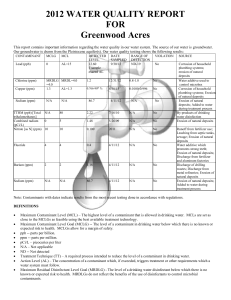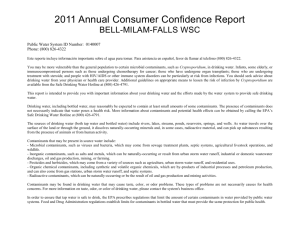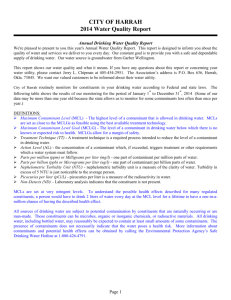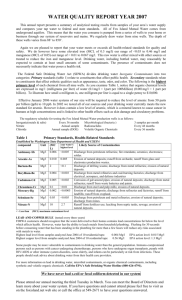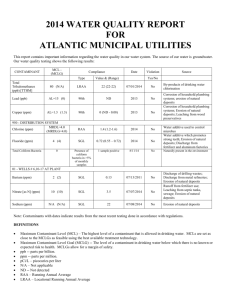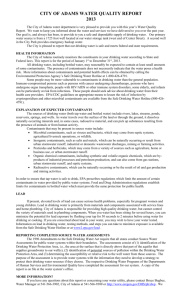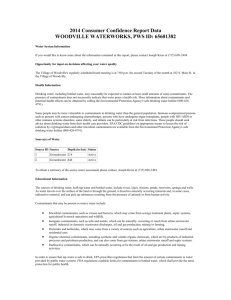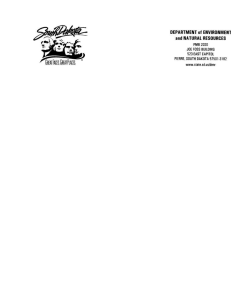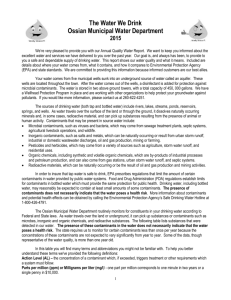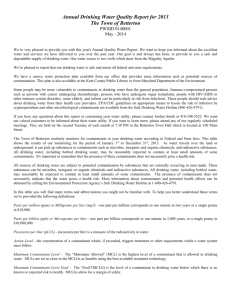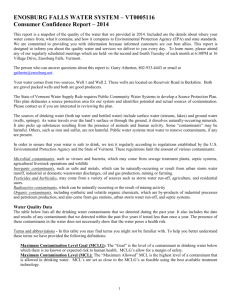Annual Water Quality Report
advertisement
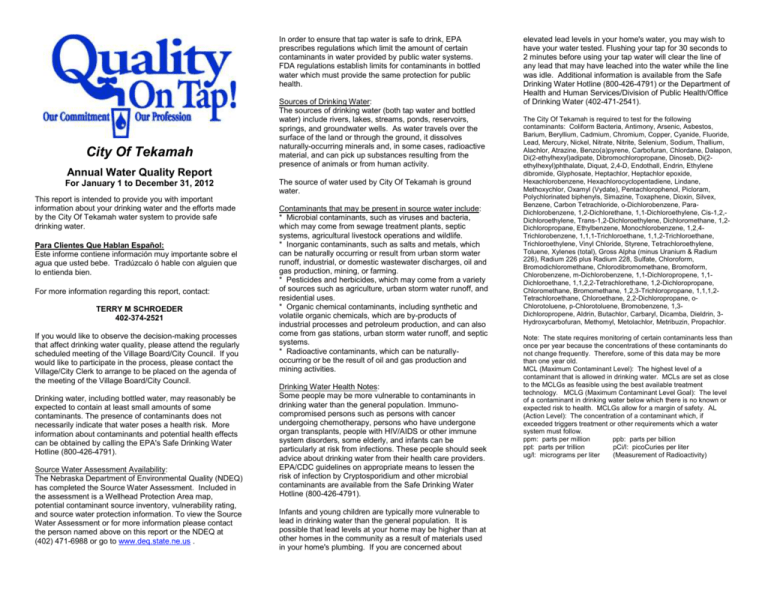
In order to ensure that tap water is safe to drink, EPA prescribes regulations which limit the amount of certain contaminants in water provided by public water systems. FDA regulations establish limits for contaminants in bottled water which must provide the same protection for public health. City Of Tekamah Annual Water Quality Report For January 1 to December 31, 2012 This report is intended to provide you with important information about your drinking water and the efforts made by the City Of Tekamah water system to provide safe drinking water. Para Clientes Que Hablan Español: Este informe contiene información muy importante sobre el agua que usted bebe. Tradúzcalo ó hable con alguien que lo entienda bien. For more information regarding this report, contact: TERRY M SCHROEDER 402-374-2521 If you would like to observe the decision-making processes that affect drinking water quality, please attend the regularly scheduled meeting of the Village Board/City Council. If you would like to participate in the process, please contact the Village/City Clerk to arrange to be placed on the agenda of the meeting of the Village Board/City Council. Drinking water, including bottled water, may reasonably be expected to contain at least small amounts of some contaminants. The presence of contaminants does not necessarily indicate that water poses a health risk. More information about contaminants and potential health effects can be obtained by calling the EPA's Safe Drinking Water Hotline (800-426-4791). Source Water Assessment Availability: The Nebraska Department of Environmental Quality (NDEQ) has completed the Source Water Assessment. Included in the assessment is a Wellhead Protection Area map, potential contaminant source inventory, vulnerability rating, and source water protection information. To view the Source Water Assessment or for more information please contact the person named above on this report or the NDEQ at (402) 471-6988 or go to www.deq.state.ne.us . Sources of Drinking Water: The sources of drinking water (both tap water and bottled water) include rivers, lakes, streams, ponds, reservoirs, springs, and groundwater wells. As water travels over the surface of the land or through the ground, it dissolves naturally-occurring minerals and, in some cases, radioactive material, and can pick up substances resulting from the presence of animals or from human activity. The source of water used by City Of Tekamah is ground water. Contaminants that may be present in source water include: * Microbial contaminants, such as viruses and bacteria, which may come from sewage treatment plants, septic systems, agricultural livestock operations and wildlife. * Inorganic contaminants, such as salts and metals, which can be naturally occurring or result from urban storm water runoff, industrial, or domestic wastewater discharges, oil and gas production, mining, or farming. * Pesticides and herbicides, which may come from a variety of sources such as agriculture, urban storm water runoff, and residential uses. * Organic chemical contaminants, including synthetic and volatile organic chemicals, which are by-products of industrial processes and petroleum production, and can also come from gas stations, urban storm water runoff, and septic systems. * Radioactive contaminants, which can be naturallyoccurring or be the result of oil and gas production and mining activities. Drinking Water Health Notes: Some people may be more vulnerable to contaminants in drinking water than the general population. Immunocompromised persons such as persons with cancer undergoing chemotherapy, persons who have undergone organ transplants, people with HIV/AIDS or other immune system disorders, some elderly, and infants can be particularly at risk from infections. These people should seek advice about drinking water from their health care providers. EPA/CDC guidelines on appropriate means to lessen the risk of infection by Cryptosporidium and other microbial contaminants are available from the Safe Drinking Water Hotline (800-426-4791). Infants and young children are typically more vulnerable to lead in drinking water than the general population. It is possible that lead levels at your home may be higher than at other homes in the community as a result of materials used in your home's plumbing. If you are concerned about elevated lead levels in your home's water, you may wish to have your water tested. Flushing your tap for 30 seconds to 2 minutes before using your tap water will clear the line of any lead that may have leached into the water while the line was idle. Additional information is available from the Safe Drinking Water Hotline (800-426-4791) or the Department of Health and Human Services/Division of Public Health/Office of Drinking Water (402-471-2541). The City Of Tekamah is required to test for the following contaminants: Coliform Bacteria, Antimony, Arsenic, Asbestos, Barium, Beryllium, Cadmium, Chromium, Copper, Cyanide, Fluoride, Lead, Mercury, Nickel, Nitrate, Nitrite, Selenium, Sodium, Thallium, Alachlor, Atrazine, Benzo(a)pyrene, Carbofuran, Chlordane, Dalapon, Di(2-ethylhexyl)adipate, Dibromochloropropane, Dinoseb, Di(2ethylhexyl)phthalate, Diquat, 2,4-D, Endothall, Endrin, Ethylene dibromide, Glyphosate, Heptachlor, Heptachlor epoxide, Hexachlorobenzene, Hexachlorocyclopentadiene, Lindane, Methoxychlor, Oxamyl (Vydate), Pentachlorophenol, Picloram, Polychlorinated biphenyls, Simazine, Toxaphene, Dioxin, Silvex, Benzene, Carbon Tetrachloride, o-Dichlorobenzene, ParaDichlorobenzene, 1,2-Dichlorethane, 1,1-Dichloroethylene, Cis-1,2,Dichloroethylene, Trans-1,2-Dichloroethylene, Dichloromethane, 1,2Dichloropropane, Ethylbenzene, Monochlorobenzene, 1,2,4Trichlorobenzene, 1,1,1-Trichloroethane, 1,1,2-Trichloroethane, Trichloroethylene, Vinyl Chloride, Styrene, Tetrachloroethylene, Toluene, Xylenes (total), Gross Alpha (minus Uranium & Radium 226), Radium 226 plus Radium 228, Sulfate, Chloroform, Bromodichloromethane, Chlorodibromomethane, Bromoform, Chlorobenzene, m-Dichlorobenzene, 1,1-Dichloropropene, 1,1Dichloroethane, 1,1,2,2-Tetrachlorethane, 1,2-Dichloropropane, Chloromethane, Bromomethane, 1,2,3-Trichloropropane, 1,1,1,2Tetrachloroethane, Chloroethane, 2,2-Dichloropropane, oChlorotoluene, p-Chlorotoluene, Bromobenzene, 1,3Dichloropropene, Aldrin, Butachlor, Carbaryl, Dicamba, Dieldrin, 3Hydroxycarbofuran, Methomyl, Metolachlor, Metribuzin, Propachlor. Note: The state requires monitoring of certain contaminants less than once per year because the concentrations of these contaminants do not change frequently. Therefore, some of this data may be more than one year old. MCL (Maximum Contaminant Level): The highest level of a contaminant that is allowed in drinking water. MCLs are set as close to the MCLGs as feasible using the best available treatment technology. MCLG (Maximum Contaminant Level Goal): The level of a contaminant in drinking water below which there is no known or expected risk to health. MCLGs allow for a margin of safety. AL (Action Level): The concentration of a contaminant which, if exceeded triggers treatment or other requirements which a water system must follow. ppm: parts per million ppb: parts per billion ppt: parts per trillion pCi/l: picoCuries per liter ug/l: micrograms per liter (Measurement of Radioactivity) TEST RESULTS City Of Tekamah Microbiological Highest No. of Positive Samples COLIFORM (TCR) In the month of November, 3 sample(s) were positive Date Printed: 2/6/2016 MCL MCL: Systems that Collect Less Than 40 Samples per Month - No more than 1 positive monthly sample NE3102102 MCLG Likely Source Of Contamination Violations Present 0 Naturally present in the environment Yes Lead and Copper Monitoring Period 90th Percentile Range Unit AL Sites Over AL COPPER, FREE 2011 - 2013 0.153 0.0448 0.162 ppm 1.3 0 LEAD 2011 - 2013 7.36 1.31 - 10.6 ppb 15 0 Range Unit MCL MCLG Likely Source Of Contamination ppm 2 2 Discharge from drilling wastes; Discharge from metal refineries; Erosion of natural deposits. ppb 100 100 Discharge from steel and pulp mills; Erosion of natural deposits. ppm 4 4 ppm 10 10 Regulated Contaminants Collection Date Highest Value BARIUM 02/23/2009 0.177 CHROMIUM 02/23/2009 10.2 FLUORIDE 02/23/2009 0.62 NITRATE-NITRITE 05/03/2012 17.7 Radiological Contaminants COMBINED RADIUM (-226 & 228) GROSS ALPHA, INCL. RADON & U RADIUM-226 RADIUM-228 0.0645 - 0.177 3.67 10.2 0.38 0.62 2.25 17.7 Likely Source Of Contamination Erosion of natural deposits; Leaching from wood preservatives; Corrosion of household plumbing. Erosion of natural deposits; Leaching from wood preservatives; Corrosion of household plumbing. Erosion of natural deposits; water additive which promotes strong teeth; Fertilizer discharge. Runoff from fertilizer use; Leaching from septic tanks, sewage; Erosion of natural deposits Collection Date Highest Value Range Unit MCL MCLG Likely Source Of Contamination 04/09/2012 1.7 1.1 - 1.7 pCi/l 5 0 Erosion of natural deposits 04/09/2012 2.1 2.1 pCi/l 15 0 Erosion of natural deposits 12/05/2012 04/09/2012 0.4 1.5 0.2 - 0.4 0.9 - 1.5 pCi/l pCi/l 5 5 0 0 Erosion of natural deposits Erosion of natural deposits During the 2012 calendar year, we had the below noted violation(s) of drinking water regulations. Type Category MCL (TCR), MONTHLY Maximum Contaminant Level Violation Analyte COLIFORM (TCR) Compliance Period 11/01/2012 - 11/30/2012 The City Of Tekamah has taken the following actions to return to compliance with the Nebraska Safe Drinking Water Act: The City of Tekamah began immediate chlorination upon getting the information that the repeat samples taken the last part of November had failed. The City of Tekamah chlorinated the water from Nov 27 till Dec 10 th t all samples since November 2012 have returned with no detection of coliform. . Additional Required Health Effects Language: Coliforms are bacteria that are naturally present in the environment and are used as an indicator that other potentially harmful bacteria may be present. Coliforms were found in more samples than allowed and this was a warning of potential problems. Infants below the age of six months who drink water containing nitrate in excess of the MCL could become seriously ill and, if untreated, may die. Symptoms include shortness of breath and blue baby syndrome.
